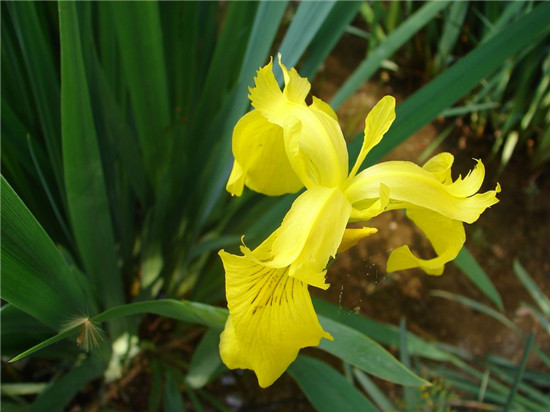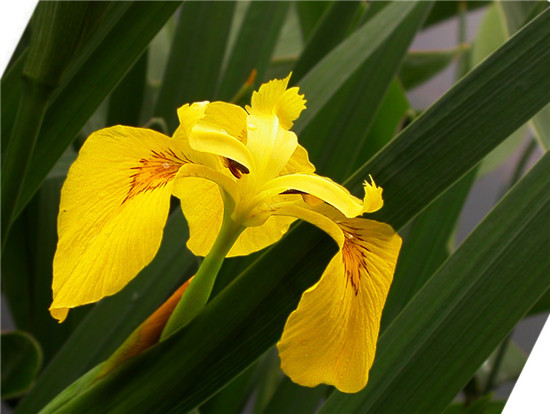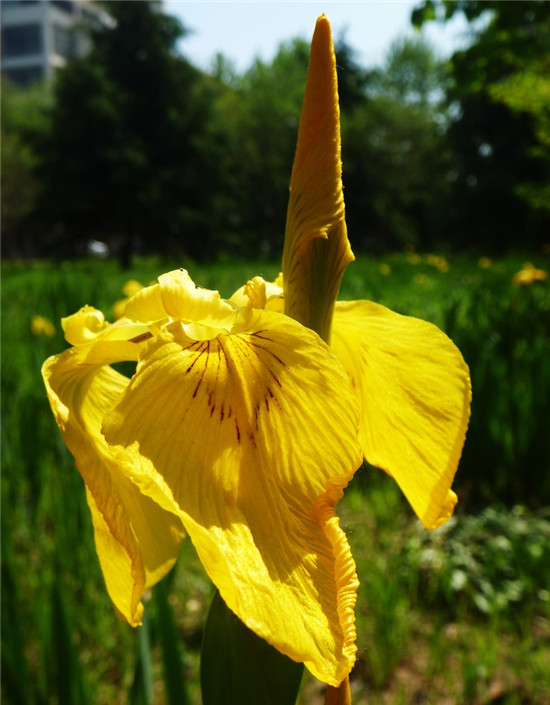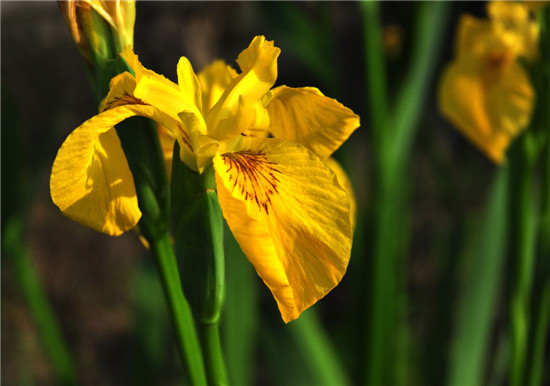How to maintain the flowers of Gladiolus
Acorus calamus, also known as yellow iris, aquatic iris, yellow iris, etc., is a perennial wet or water perennial herbaceous plants, and then let's take a look at how to maintain the flowers of Gladiolus.

Acorus calamus flower stem stout, 60-70 cm high, 4-6 mm in diameter, with distinct longitudinal ribs, upper branches, cauline leaves shorter and narrower than basal leaves; bracts 3-4, green, membranous, lanceolate, 6.5-8.5 cm long, 1.5-2 cm wide, apex acuminate; flowers yellow, stamens ca. 3 cm long, filaments yellow-white, anthers black-purple.
Style branches yellowish, ca. 4.5 cm long and 1.2 cm wide, apical lobe semicircular, margin sparsely dentate; ovary green, trigonous-columnar, ca. 2.5 mm long, ca. 5 mm in diam.
The flowering stem of Acorus tatarinowii is slightly higher than the leaf, the vertical petal is long oval, the base is nearly as wide, brown striped or absent, the flag petal is yellowish, and the flower diameter is 8 meters. Capsule long, with many seeds, seeds brown, angular.
The florescence is from May to June. Acorus tatarinowii is the proud son of aquatic flowers with yellow color, beautiful posture and high ornamental value. It has a wide range of adaptation and can be cultivated in the open field near the pool or in the water.

Acorus tatarinowii has strong adaptability, leaves and flowers are especially dense, which are widely used in wetland waterscape. Whether it is configured by the lake or by the pool. The waterscape displayed is poetic and picturesque.
At the turn of spring and summer, decorate the living room with several gladiolus bottles, which makes people relaxed and happy. Yellow calamus is also a good medicine. Dry roots can relieve toothache, regulate menstruation and cure diarrhea. It can also be used as a dye. With the acceleration of urban and rural waterscape construction, the use of Acorus tatarinowii is increasing.
[reproduction] sowing and splitting
(1) sowing: after the fruit is ripe in autumn, the harvested berries can be washed and sown indoors, keep the substrate moist or shallow water after sowing, and germinate one after another in the following spring at a temperature of about 20 ℃. The seedlings were transplanted once after germination and growth, and then planted after the seedlings grew up.

(2) ramet: combine to turn the basin after the spring is warm or in the growing period. Dig out the plant with the underground stem, wash it, cut off the old root, old stem and dead leaves, cut the underground stem into several pieces with a sharp knife, retain 3-4 new buds and part of the root system, and then plant them respectively. During the growing period, the ramet is divided into several clumps, each with a portion of rhizome, root and leaf clumps, and 2 prime 3 of the leaf length is cut off and then planted. When ramet, care should be taken to minimize damage to young leaves and new buds.
How to maintain the flowers of Gladiolus
(1) temperature: like warmth, and the most suitable temperature for growth is 20-25 ℃. It is not cold-resistant and stops growing when it is less than 10 ℃. There are rules on the ground in winter, and new buds will grow the following spring.
(2) moisture: like shallow water environment, usually should keep shallow water or damp. Do not make the basin soil dry, otherwise the plant growth is poor and the leaves are withered and yellow. When the water in the basin is reduced, water should be added in time to keep the water in the basin at a certain depth.

(3) fertilization: fertilizer was applied once a month during the growing period, nitrogen was the main fertilizer at the initial stage, and potash fertilizer should be applied before and after heading and flowering. It is appropriate to use solid fertilizer for fertilization, and put the fertilizer into about 5 meters of mud depth, so as to facilitate the absorption of roots.
(4) pruning: when dead leaves are found, they should be removed in time and weeds should be pulled out at ordinary times. Clean up the dead leaves above ground before overwintering.
(5) upper basin and turning basin: choose a watertight container with an inner diameter of 40-50 cm. Apply enough basic fertilizer to the bottom of the pot and fill it with fertile lotus pond sediment or garden soil; then dig holes in the middle to plant human roots or seedlings, and make sure that the growing point is exposed to the soil surface; finally, add water and keep the water depth of 1-3 cm. The old plant planted for 2 years needs to be turned over, and the soil can use ordinary garden soil.
The above is the whole content of how to protect the gladiolus flowers for you. I hope this article can help you. Please continue to follow us.
Related
- Wuhan Hospital Iron Tree Blooming Result Was Instantly Frightened by the Gardener Master
- Which variety of camellia is the most fragrant and best? Which one do you like best?
- What is the small blue coat, the breeding methods and matters needing attention of the succulent plant
- Dormancy time and maintenance management of succulent plants during dormancy
- Minas succulent how to raise, Minas succulent plant pictures
- What are the varieties of winter succulent plants
- How to raise succulent plants in twelve rolls? let's take a look at some experience of breeding twelve rolls.
- Attention should be paid to water control for succulent plants during dormant period (winter and summer)
- Watering experience of twelve rolls of succulent plants
- Techniques for fertilizing succulent plants. An article will let you know how to fertilize succulent plants.



